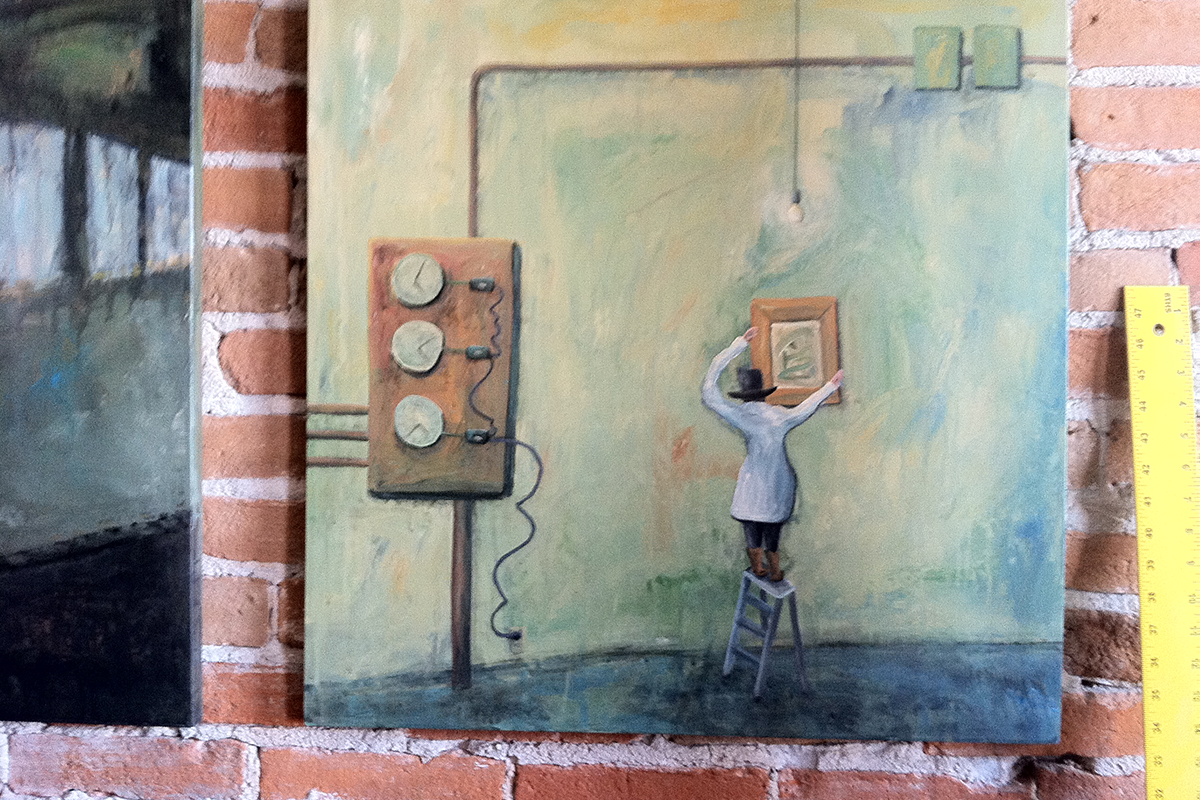Artist statement from Instrumentation of Being: Inner Contours and The Personification of Place.
A few years ago I was fortunate enough to walk through the abandoned railroad shops situated in the middle of Livingston, Montana. Not knowing what visual rarities I was about to encounter, I was unprepared for the experience. My time in these cavernous shells of bygone industry was limited—due to corporate protocols and safety concerns, I had less than two hours. As the “safety officer” guided me through dilapidated machine shops and vacant yards I stopped to ponder why this once vibrant heart of the town, the largest rail hub in the region at one point, was essentially a mystery to many current residents. I was a foreigner in the center of my own town.
I left the neglected structures that day with a stack of sketches under one arm, a digital camera packed with images, and an uneasy, detached feeling. How could I be so removed from my surroundings? Were we all just tourists trying to connect to our environment? Did this place called Montana have any real meaning or was it all just contrived mythology? How did all of the nondescript, man-made objects in the foreground of my “Big Sky” panorama shape who I was?
When I entered the art studio to begin the body of work you see before you, I realized the real beauty of my discovery. The essence of what I was about to paint had to do with… nothingness: the unanswered questions inside the decaying buildings.
The paintings in “Instrumentation of Being: Inner Contours and The Enigma of Place” vaguely resemble the actual Livingston railroad shops. Photo historians will be greatly disappointed, as the paintings do not visually adhere to physical structures. What they do adhere to is the notion of ambiguity and our inherent desire to apply meaning to life’s many mysteries.
The people in the paintings are somewhat out of place, probing for answers, monitoring. Spacious industrial landscapes are reinforced by architectural fragments and abstract infrastructure. Low-tech gadgets, odd instruments and misplaced electrical boxes add to the puzzlement. Peculiar activities are taking place in an effort to validate our humanness.
The paintings are meant to engage the viewer on many levels—they hinge on the central ideas of self discovery, applied meaning and connection to place. The pieces of the puzzle are meant to work in tandem to build intrigue and challenge the viewer.
I firmly believe the role of the artist is not to answer questions, but to pose questions. I ask the viewer, as an active participant, to take these questions and continue the dialogue.
Fictional newpaper article written by Brad Bunkers and displayed at the Instrumentation of Being exhibition:
International travelers have been making the trek to Yellowstone for years but this summer a new type of tourism has been taking place in the foothills above Hornaday Creek. German psychologist, Dr. Hans Betrügerisch, and his band of leading Scientists have been stationed in the northern section of Yellowstone since early May.
Why are there German Scientists in white lab coats roaming Yellowstone? It turns out Dr. Betrügerisch has unearthed unique chemical compounds that have resulted in a considerable scientific breakthrough. According to Rutgers University Journal, Dr. Betrügerisch and his team have figured out how to capture the human psyche on film. Using the latest photo-biology and radiowave technology and the newly-discovered chemical connection from Yellowstone, anyone’s spsyche can now be seen.
Dr. Betrügerisch and his group have been conducting the psyche capturing experiments in abandoned YNP machine shops just north of Cache Creek. This remote industrial complex was the perfect location to work on such a secretive project.
Security was not an issue in the isolated lab but the scientists had to contend with curious wildlife including coyotes, bears and a rambunctious skunk they named, “Nachstank!” It is unknown if the new psyche capturing technique can be applied to animals but Dr. Betrügerisch intends on continuing research next spring and animals could become subjects.
Dr. Betrügerisch’s printed psyche images have been dubbed “DasFoto Depictus” by the C. G. Jung Institute–Stuttgart. The images will be on view at the University of Montana sometime in 1976. Dr. Betrügerisch plans to lecture at the Universtiy before touring the region with his research findings …
© Brad Bunkers, all rights reserved


0 Comments